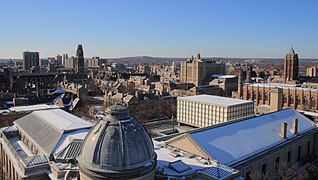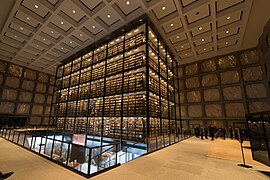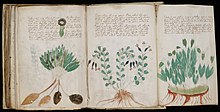Rare book library at Yale University in New Haven, Connecticut
| Beinecke Rare Book & Manuscript Library | |
|---|---|
 (2024) (2024) | |
| 41°18′42″N 72°55′38″W / 41.31161°N 72.92722°W / 41.31161; -72.92722 | |
| Location | New Haven, Connecticut |
| Established | 1963 (1963) |
| Architect(s) | Gordon Bunshaft |
| Collection | |
| Items collected | Rare books and manuscripts |
| Other information | |
| Parent organization | Yale University |
| Website | www |
The Beinecke Rare Book & Manuscript Library (/ˈbaɪnɪki/) is the rare book library and literary archive of the Yale University Library in New Haven, Connecticut. It is one of the largest buildings in the world dedicated to rare books and manuscripts and is one of the largest collections of such texts. Established by a gift of the Beinecke family and given its own financial endowment, the library is financially independent from the university and is co-governed by the University Library and Yale Corporation.
Situated on Yale University's Hewitt Quadrangle, the building was designed by Gordon Bunshaft of Skidmore, Owings & Merrill and completed in 1963. From 2015 to 2016 the library building was closed for 18 months for major renovations, which included replacing the building's HVAC system and expanding teaching and exhibition capabilities.
Architecture
The Beinecke Library is an International Style building. Its six-story above-ground glass-enclosed tower of book stacks is encased by a windowless façade, supported by four monolithic piers at the corners of the building. The exterior shell is structurally supported by a steel frame with pylons embedded 50 feet (15 m) to bedrock at each corner pier, and the façade is constructed of translucent veined marble and granite. The marble was quarried from Danby, Vermont, and milled to a thickness of 1.25 inches (32 mm) in order to allow filtered daylight to permeate the interior in a subtle golden amber glow. Gordon Bunshaft attributed the inspiration for this effect to "what I thought was onyx in a Renaissance-type palace in Istanbul," referring to the alabaster used in the Dolmabahçe Palace hammam.
These panels are framed by a hexagonal grid of Vermont Woodbury granite veneer, fastened to a structural steel frame. The outside dimensions have Platonic mathematical proportions of 1:2:3 (height: width: length). The building has been called a "jewel box", "treasure casket" (by Bunshaft himself), and a "laboratory for the humanities". It contains furniture designed by Florence Knoll and Marcel Breuer.
An elevated public exhibition mezzanine surrounds the glass stack tower, and displays among other things, one of the 48 extant copies of the Gutenberg Bible. Two basement floors extend under much of Hewitt Quadrangle. The first sub-grade level, the "Court" level, centers on a sunken courtyard in front of the Beinecke, which features The Garden (Pyramid, Sun, and Cube). These are abstract allegorical sculptures by Isamu Noguchi that are said to represent time (the pyramid), sun (the disc), and chance (the cube). This level also features a secure reading room for visiting researchers, administrative offices, and book storage areas. The level of the building two floors below ground has movable-aisle high-density shelving for books and archives.
The Beinecke is one of the larger buildings in America devoted entirely to rare books and manuscripts. The library has room in the central tower for 180,000 volumes and room for over 1 million volumes in the underground book stacks. The library's collection, which is housed both in the library's main building and at Yale University's Library Shelving Facility in Hamden, Connecticut, totals roughly 1 million volumes and several million manuscripts.
During the 1960s, the Claes Oldenburg sculpture Lipstick (Ascending) on Caterpillar Tracks was displayed in Hewitt Quadrangle. The sculpture has since been moved to the courtyard of Morse College, one of the university's residential dormitories.
The design of the Beinecke Library later inspired the glass-walled structure that protects and displays the original core collection (the books given by King George III and referred to as the King's Library) within the British Library building in Euston, London.
- Gallery
-
 The Beinecke Library in architectural context, including Woolsey Hall in the foreground
The Beinecke Library in architectural context, including Woolsey Hall in the foreground
-
Exterior view at night
-
 Closeup of the building's geometric exterior
Closeup of the building's geometric exterior
-
 Sunlight through the building's marble panels supplements the interior's artificial lighting
Sunlight through the building's marble panels supplements the interior's artificial lighting
History

In the late 19th century, rare and valuable books of the Library of Yale College were placed on special shelving at the College Library, now known as Dwight Hall. When the university received a multimillion-dollar bequest from John W. Sterling for the construction of Sterling Memorial Library in 1918, the university decided to create a dedicated reading room for its rare books, which became the building's Rare Book Room when the building opened in 1930. Because the bequest did not contain an allowance for books or materials, Yale English professor Chauncey Brewster Tinker petitioned Yale alumni to donate materials that would give the university a collection as monumental as its new building. By the time Sterling opened, Tinker's appeal garnered an impressive collection of rare books, including a Gutenberg Bible from Anna M. Harkness and several major collections from the Beinecke family, most notably its collection on the American West.

By 1958, the library owned more than 130,000 rare volumes and many more manuscripts. The amassed collection proved too large for Sterling's reading room, and the reading room unsuited to their preservation. Having already given significant collections to Yale, Edwin and Frederick W. Beinecke—as well as Johanna Weigle, widow of their brother Walter—gave funds to build a dedicated rare books library building. When the Beinecke Library opened on October 14, 1963, it became the home of the volumes from Rare Book Room, and three special collections: the Collection of American Literature, the Collection of Western Americana, and the Collection of German Literature. Shortly afterward, they were joined by the James Marshall and Marie-Louise Osborn Collection.
Beinecke Library became the repository for books in the Yale collection printed anywhere before 1800, books printed in Latin America before 1751, books printed in North America before 1821, newspapers and broadsides printed in the United States before 1851, European tracts and pamphlets printed before 1801, and Slavic, East European, Near and Middle Eastern books through the eighteenth century, as well as special books outside these categories.
Now, the collection spans through to the present day, including such modern works as limited-edition poetry and artists' books. The library also contains thousands of linear feet of archival material, ranging from ancient papyri and medieval manuscripts to the archived personal papers of modern writers.
Special collections


The library is open to all Yale University students and faculty, and to visiting researchers whose work requires use of its special collections. In order to access materials, there are a few forms and policies that users must read.
The Beinecke Library also hold several hundred items from special collections institution Pequot Library. The collection consists largely of correspondence and documents from the colonial, revolutionary, Federal, and antebellum periods, extending well into the postbellum era.
The holdings of the Beinecke Library include:
- American Children's Literature
- John James Audubon
- James M. Barrie
- John Baskerville
- William Thomas Beckford
- Sir John Betjeman
- James Boswell
- John Boswell
- Joseph Brodsky
- Bryher
- Mary Butts
- Rachel Carson
- Cartography, including the "Vinland Map"
- Cary Collection of Playing Cards
- Ernst Cassirer
- Congregationalism
- Joseph Conrad
- Walter Crane
- Dada
- The d'Aulaire Collection (Ingri and Edgar Parin d'Aulaire)
- Daniel Defoe
- Charles Dickens
- Norman Douglas
- Lawrence Durrell
- Jonathan Edwards
- George Eliot
- The Elizabethan Club collection
- Erasmus and his contemporaries
- Faust
- Fantasy Magazine Archives
- Henry Fielding
- Benjamin Franklin
- Goethe
- George Grosz
- Greek and Latin literature
- Thomas Hardy
- H.D. Papers
- W. Head & Sister, photographers
- Langston Hughes
- Humanism
- Incunabula (over 3100 volumes including the Melk copy of the Gutenberg Bible)
- James Weldon Johnson Collection
- James Joyce
- Judaica
- Rudyard Kipling
- D. H. Lawrence
- Doris Lessing
- Sinclair Lewis
- Pre-1600 manuscripts
- Thomas Mann
- F. T. Marinetti
- John Masefield
- F. O. Matthiessen
- The Mellon Collection of Alchemy and the Occult
- George Meredith
- William J. Minor Horse Racing Papers.
- Eugene O'Neill Jr.
- Ornithology
- the Papyrus Collection
- Polish Literature
- Pop-up books and movable books
- Ezra Pound Papers
- Dorothy Richardson
- Rilke
- Rochambeau Family
- Bruce Rogers
- the Romanov Family photo albums
- Olga Rudge Papers
- John Ruskin
- Russian Literature
- Schiller
- Miriam Schlein
- Sixteenth-Century Printed Books
- Sporting Books
- The Gertrude Stein and Alice B. Toklas Collection
- Robert Louis Stevenson
- James J. Strang
- Monroe, Wakeman, and Holman Collection of the Pequot Library Association
- Alexis de Tocqueville
- Vanderbilt Collection
- Carl Van Vechten
- Paula Vogel
- The Voynich manuscript
- Rebecca West
- Edith Wharton
- The Thornton Wilder papers
- Kurt Wolff
Exhibitions

In addition to items on permanent display such as the Gutenberg Bible, the Beinecke offers a year-round program of temporary exhibits drawn from its collections. For example, in 2006 the library presented Breaking the Binding: Printing and the Third Dimension, a show of flap books, pop-ups, perspective books, panoramas, and peep-shows in printed form. Display cases are located on the mezzanine level and at the ground floor entry level, and may be freely viewed by the general public whenever the library is open.
The Library celebrated its 50th anniversary in 2013. There were two full-year exhibitions that explored the library's architecture and people as well as a series of showcases of rarely seen manuscripts, printed works, and visual objects from across all curatorial areas.
Security
The Beinecke collection does not circulate; all materials are to be consulted in the reading room. The library hosts almost 10,000 research visits annually, almost half of which are with scholars having no formal affiliation to Yale University.
Security measures were significantly increased after the well-known antiques dealer Edward Forbes Smiley III was caught cutting maps from rare books with an X-acto blade in 2005. Smiley's scheme was discovered when he dropped his concealed tool in the reading room, and he subsequently served several years in prison for thefts of rare documents valued in millions of dollars from the Beinecke and other libraries. The library operates under a closed stack system, and rigorous security rules now allow carefully controlled access to materials under video surveillance.
The glass-enclosed central stacks (not accessible to the public) can be flooded with a mix of Halon 1301 and Inergen fire suppressant gas if fire detectors are triggered. A previous system using carbon dioxide was removed for personnel safety reasons.
After an infestation of the death watch beetle was discovered in 1977, the Beinecke Library helped pioneer the non-toxic method of controlling paper-eating pests by freezing books and documents at −33 °F (−36 °C) for three days. All new acquisitions are given this treatment as a precaution, and the deep freeze method is now widely accepted for pest control in special collections libraries.
In popular culture
- In Uncommon Carriers, John McPhee admires a restaurant's display of "a glass tower of recumbent wines that may have been an architectural reference to the glass column of visible books in the Beinecke Library at Yale".
- In The Once and Future Spy by Robert Littell, an assassination attempt is made on a CIA analyst at the Beinecke Library.
- In The Ninth House, the Beinecke Library is made a site for cult practice by Manuscript Society.
See also
Notes
- The Audubon collection includes two copies of the double elephant folio of Birds of America
- The Elizabethan Club collection is composed of about 300 volumes of 16th- and 17th-century literature, including the first four folios of Shakespeare, the Huth Shakespeare quartos, and first or early quartos of all the major dramatists
- Early manuscripts including more than 1,100 medieval and Renaissance codices and several hundred manuscript fragments dating from the fourth century through the Renaissance, as well as the Voynich Manuscript
References
- ^ "About the Building | Beinecke Rare Book & Manuscript Library". beinecke.library.yale.edu. December 20, 2018. Retrieved March 30, 2019.
- ^ Fellman, Bruce (February 2002). "Leading the Libraries". Yale Alumni Magazine. Yale Alumni Publications, Inc. Retrieved June 3, 2012.
- "Gordon Bunshaft on Beinecke Library". Som.com. Archived from the original on June 8, 2011. Retrieved June 1, 2011.
- "Yale University – Beinecke Rare Book and Manuscript Library". SOM.com. Archived from the original on June 8, 2011. Retrieved June 1, 2011.
- "Beinecke Library Renovation". beineckelibraryrenovation.yale.edu. Yale University. Retrieved February 20, 2017.
- ^ Blum, Betty J. (2000). Oral History of Gordon Bunshaft. Chicago: The Art Institute of Chicago.
- Yücel, İhsan (1995). Dolmabahçe Palace. Istanbul: TBMM Department of National Palaces. ISBN 975-7479-42-X.
- Figueres, Enzo (November 2012). "New Haven Architecture" (PDF). The Arts Paper. Arts Council of Greater New Haven.
- "About the Library Building: Online Tour". Yale University Beinecke Rare Book and Manuscript Library. Yale University Beinecke Rare Book and Manuscript Library. Retrieved June 3, 2012.
- ^ Waytkus, Liz. "Beinecke Rare Book and Manuscript Library". docomomo_us. Docomomo US. Retrieved June 3, 2012.
- Cronin, Brena (July 22, 2016). "Library of Treasures Gets an Overhaul". The Wall Street Journal. p. D5.
- "The Garden (Pyramid, Sun, and Cube)". Public Art at Yale. Yale University. Archived from the original on June 30, 2012. Retrieved June 4, 2012.
- ^ Kopley, Emily (November 2005). "Beneath the Beinecke". The New Journal: The Magazine about Yale and New Haven, since 1967. Retrieved June 4, 2012.
- MacCarthy, Fiona (February 22, 2008). "A house for the mind". The Guardian. Retrieved January 7, 2019.
- ^ Taylor, Merrily E. (1978). The Yale University Library 1701–1978: its History, Collections, and Present Organization. New Haven: Yale University Library.
- Parks, Stephen, ed. (2007). The Beinecke Library of Yale University. New Haven: Yale University Press. ISBN 978-0-300-13398-1.
- Planning Your Research Visit | Beinecke Rare Book & Manuscript Library. Beinecke.library.yale.edu. Retrieved April 12, 2014
- "Collection: Manuscripts in the Monroe, Wakeman, and Holman Collection of the Pequot Library Association | Archives at Yale". archives.yale.edu. Retrieved September 12, 2023.
- Yale University Library: Guide to the William J. Minor Horse Racing Papers
- "Exhibitions". Yale University Beinecke Rare Book and Manuscript Library. Yale University Beinecke Rare Book and Manuscript Library. Retrieved June 3, 2012.
- "Breaking the Binding: Printing and the Third Dimension | Beinecke Rare Book & Manuscript Library". beinecke.library.yale.edu. Yale University. Archived from the original on April 9, 2018. Retrieved February 20, 2017.
- Special Events | Beinecke Rare Book & Manuscript Library Archived February 2, 2014, at the Wayback Machine. Beinecke.library.yale.edu. Retrieved April 12, 2014
- Beinecke Rare Book & Manuscript Library. "50th Anniversary". Archived from the original on October 2, 2013. Retrieved September 9, 2013.
- Finnegan, William (October 17, 2005). "A theft in the library: the case of the missing maps". The New Yorker. Conde Nast. pp. 64–80. Retrieved June 22, 2013.
- "Reading Room Rules" (PDF). Yale University Beinecke Rare Book and Manuscript Library. Yale University Beinecke Rare Book and Manuscript Library. Retrieved June 3, 2012.
- ^ Tidmarsh, David (February 4, 2010). "Myths abound about Beinecke". Yale Daily News. Retrieved April 13, 2016.
- "Preserving the World's Literary Heritage ... One Library at a Time" (PDF). hillerne.com. Hiller New England Fire Protection. Archived from the original (PDF) on August 28, 2008. Retrieved June 4, 2012.
- Heymann, C. David (June 11, 1978). "Rare Bookman". The New York Times. Archived from the original on June 14, 2018.
- McPhee, John (2006). Uncommon Carriers. Farrar, Straus and Giroux. ISBN 0-374-28039-8., p. 129
Further reading
- Parks, Stephen, ed. (2003). The Beinecke Library of Yale University. Yale University (Conn.): Beinecke Rare Book and Manuscript Library. ISBN 0-8457-3150-5.
External links
- Beinecke renovation website
- Online Tour of the Beinecke Library Building
- African American Studies at Beinecke Library Blog
- Beinecke Poetry Blog
- Room 26: Cabinet of Curiosities Blog – Blog of visual materials from the Beinecke's collections by Beinecke curatorial staff
- Beinecke Library Construction Photographs, 1961–1963
- Beinecke Rare Book and Manuscript Library Exhibition Materials. General Collection, Beinecke Rare Book and Manuscript Library, Yale University.
| Yale University Library | ||
|---|---|---|
| Facilities |  | |
| History and collections | ||
| Prizes | ||
| Yale University | |||||||||||
|---|---|---|---|---|---|---|---|---|---|---|---|
| People |
|  | |||||||||
| Schools |
| ||||||||||
| Campus | |||||||||||
| Residential | |||||||||||
| Library and museums | |||||||||||
| Research | |||||||||||
| Athletics |
| ||||||||||
| Artistic | |||||||||||
| Traditions | |||||||||||
| Publications | |||||||||||
| Books | |
|---|---|
| Production | |
| Consumption | |
| By country | |
| Other |
|
| Related | |